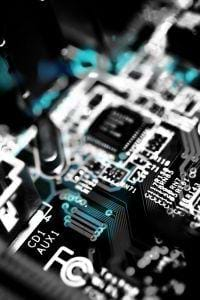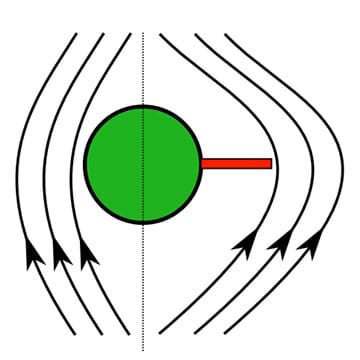Quick Look
Grade Level: 12 (10-12)
Time Required: 45 minutes
Expendable Cost/Group: US $13.00 Cost includes items you may have but will need to replace more frequently (resistors, wire, diodes, LEDs, capacitors); see the Materials List for additional necessary non-expendable (reusable) items.
Group Size: 2
Activity Dependency:
Subject Areas: Physics
NGSS Performance Expectations:

| HS-PS3-5 |

Summary
Students use a simple setup consisting of a coil of wire and a magnet to visualize induced EMF. First, they move a coil of wire near a magnet and observe the voltage that results. Then they experiment with moving the wire, magnet and a second, current-carrying coil. They connect the coil to a circuit and the current from the induced EMF charges a conductor.Engineering Connection
To create MRI machines, engineers harness the power of radiation to produce images of the body while designing the equipment to protect patient and medical personnel from any dangerous side effects. To do this, engineers who develop MRI safety strategies must be aware of voltage changes occuring in metal objects within the magnetic field as result of the motion and strength of the field. At activity end, students consider this application with respect to MRI machines in the handout questions 1-3.
Learning Objectives
After this activity, students should be able to:
- Describe the motional EMF produced when a coil of wire moves through a magnetic field or a magnetic field moves through a coil of wire.
- Explain the induced EMF when a magnetic field through a coil of wire is increased.
- Charge a conductor using current from an induced EMF.
Educational Standards
Each TeachEngineering lesson or activity is correlated to one or more K-12 science,
technology, engineering or math (STEM) educational standards.
All 100,000+ K-12 STEM standards covered in TeachEngineering are collected, maintained and packaged by the Achievement Standards Network (ASN),
a project of D2L (www.achievementstandards.org).
In the ASN, standards are hierarchically structured: first by source; e.g., by state; within source by type; e.g., science or mathematics;
within type by subtype, then by grade, etc.
Each TeachEngineering lesson or activity is correlated to one or more K-12 science, technology, engineering or math (STEM) educational standards.
All 100,000+ K-12 STEM standards covered in TeachEngineering are collected, maintained and packaged by the Achievement Standards Network (ASN), a project of D2L (www.achievementstandards.org).
In the ASN, standards are hierarchically structured: first by source; e.g., by state; within source by type; e.g., science or mathematics; within type by subtype, then by grade, etc.
NGSS: Next Generation Science Standards - Science
| NGSS Performance Expectation | ||
|---|---|---|
|
HS-PS3-5. Develop and use a model of two objects interacting through electric or magnetic fields to illustrate the forces between objects and the changes in energy of the objects due to the interaction. (Grades 9 - 12) Do you agree with this alignment? |
||
| Click to view other curriculum aligned to this Performance Expectation | ||
| This activity focuses on the following Three Dimensional Learning aspects of NGSS: | ||
| Science & Engineering Practices | Disciplinary Core Ideas | Crosscutting Concepts |
| Develop and use a model based on evidence to illustrate the relationships between systems or between components of a system. Alignment agreement: | When two objects interacting through a field change relative position, the energy stored in the field is changed. Alignment agreement: | Cause and effect relationships can be suggested and predicted for complex natural and human designed systems by examining what is known about smaller scale mechanisms within the system. Alignment agreement: |
International Technology and Engineering Educators Association - Technology
-
Medical technologies include prevention and rehabilitation, vaccines and pharmaceuticals, medical and surgical procedures, genetic engineering, and the systems within which health is protected and maintained.
(Grades
9 -
12)
More Details
Do you agree with this alignment?
-
Assess how similarities and differences among scientific, mathematical, engineering, and technological knowledge and skills contributed to the design of a product or system.
(Grades
9 -
12)
More Details
Do you agree with this alignment?
State Standards
National Science Education Standards - Science
-
Results of scientific inquiry--new knowledge and methods--emerge from different types of investigations and public communication among scientists. In communicating and defending the results of scientific inquiry, arguments must be logical and demonstrate connections between natural phenomena, investigations, and the historical body of scientific knowledge. In addition, the methods and procedures that scientists used to obtain evidence must be clearly reported to enhance opportunities for further investigation.
(Grades
9 -
12)
More Details
Do you agree with this alignment?
Tennessee - Science
-
Explore the flow of charge and electric currents.
(Grades
9 -
12)
More Details
Do you agree with this alignment?
-
Design an experiment to demonstrate the flow of charged particles and an electric current.
(Grades
9 -
12)
More Details
Do you agree with this alignment?
Materials List
Each group needs:
- 2 gilley coils*
- rubber-coated NdFeB magnet
- multimeter
- 6V lantern battery or 5V DC power wupply
- 1000-ohm resistor
- 3 wires with alligator clip leads
- several hookup wires
- diode
- LED
- 100 μF capacitor
- breadboard
- Induced EMF in a Coil of Wire Handout, one per student
* Gilley coil induction sets are available online from a number of venders for ~$50. Improvise an easy alternative by winding a 2-inch diameter coil of 100 turns using 20 gauge magnet wire held together with duct tape.
Worksheets and Attachments
Visit [www.teachengineering.org/activities/view/van_mri_act_less_8] to print or download.Introduction/Motivation
We have learned that magnets can create a current in a wire. In this lab, we will experiment with this current and then use it to charge a capacitor. Learning more about the properties of magnetic fields will help us to better understand MRI machines so we can work to solve our MRI safety challenge.
Procedure
- Gather materials and make copies of the Induced EMF in a Coil of Wire Handout.
- If desired, divide the class into small groups of two or three students each.
- Distribute the materials and handout.
- Direct students to follow the handout instructions to explore the current that is created when a loop of coil is passed over a permanent magnet.
- Then have them follow the instructions to create a circuit and use this induced EMF to light a diode.
- Conclude the activity by giving students time to individually prepare summary lab reports, as described on the handout and in the Assessment section.
Assessment
Post-Lab Assessment
Lab Reports: As directed on the Induced EMF in a Coil of Wire Handout, have students individually prepare summary lab reports that include answering the four application questions, listing their observations, and describing any problems or issues that occurred during the lab. Review their lab reports to gauge their depth of comprehension. If desired, lead a class discussion in which students share their results, conclusions and answers to the questions, paying special attention to conclusions that relate to the ongoing engineering grand challenge of the unit.
Subscribe
Get the inside scoop on all things TeachEngineering such as new site features, curriculum updates, video releases, and more by signing up for our newsletter!More Curriculum Like This

Students induce EMF in a coil of wire using magnetic fields. Students review the cross product with respect to magnetic force and introduce magnetic flux, Faraday's law of Induction, Lenz's law, eddy currents, motional EMF and Induced EMF.

Pertinent to their ongoing investigation of MRI machines, students learn the consequences of a charge being subject to electric and magnetic fields at the same time. Through several example problems, students calculate the Hall voltage, which is dependent upon plate width, drift velocity and magneti...

A class demo introduces students to the force between two current carrying loops, comparing the attraction and repulsion between the loops to that between two magnets. After a lecture on Ampere's law (including some sample cases and problems), students begin to use the concepts to calculate the magn...

Students learn about nondestructive testing, the use of the finite element method (systems of equations) and real-world impacts, and then conduct mini-activities to apply Maxwell’s equations, generate currents, create magnetic fields and solve a system of equations. They see the value of NDE and FEM...
Copyright
© 2013 by Regents of the University of Colorado; original © 2006 Vanderbilt UniversityContributors
Eric AppeltSupporting Program
VU Bioengineering RET Program, School of Engineering, Vanderbilt UniversityAcknowledgements
The contents of this digital library curriculum were developed under National Science Foundation RET grant nos. 0338092 and 0742871. However, these contents do not necessarily represent the policies of the NSF, and you should not assume endorsement by the federal government.
Last modified: April 19, 2019









User Comments & Tips